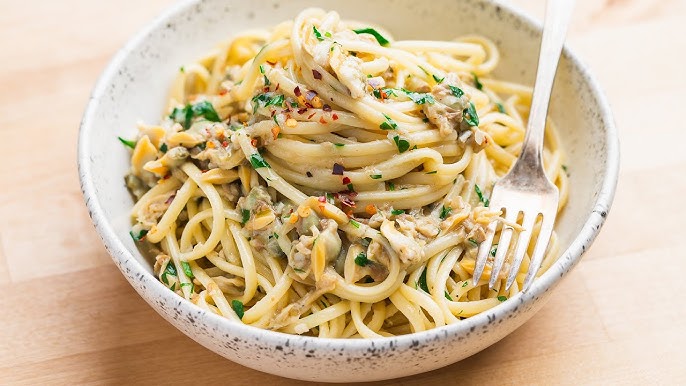Linguine with Clam Sauce Recipe: There’s something magical about a bowl of perfectly cooked pasta tossed in a rich, garlicky clam sauce. Linguine with clam sauce is one of those dishes that feels both comforting and elegant at the same time. Whether you’re making it for a quiet dinner at home, a family gathering, or even a date night, this recipe brings the flavors of the Italian coast straight to your kitchen.
In this guide, you’ll discover everything you need to make an authentic linguine with clam sauce, from the right ingredients and preparation steps to foolproof cooking techniques. I’ll walk you through each stage carefully so even if it’s your first time making this dish, you’ll be able to whip up a restaurant-quality meal at home.
A Classic Italian-American Favorite
Linguine with clam sauce is a dish that beautifully blends Italian tradition with American adaptation. In coastal Italy, clams are abundant, and locals have been tossing them into pasta for centuries. When Italian immigrants brought this recipe to America, it quickly became a staple in Italian-American households and restaurants.
The beauty of this dish lies in its simplicity—just a few ingredients, yet a symphony of flavors. The linguine acts as the perfect canvas, soaking up the clam-infused sauce made of garlic, olive oil, white wine, and fresh herbs. Unlike heavier pasta dishes loaded with cream or cheese, clam sauce is light yet flavorful, making it a refreshing option that doesn’t weigh you down.
Why This Recipe is Perfect for Weeknights and Gatherings
One of the best things about linguine with clam sauce is its versatility. On busy weeknights, you can prepare it in under 30 minutes with minimal effort. All it takes is cooking the pasta while the sauce simmers—then tossing them together for a quick, hearty dinner.
On the other hand, when you’re entertaining guests, this dish also shines as an elegant option that looks impressive but doesn’t require complicated techniques. Pair it with a glass of crisp white wine, and you’ve got yourself a meal that feels like dining at a seaside trattoria.
Ingredients You’ll Need
Fresh Ingredients for Authentic Flavor
The key to great linguine with clam sauce lies in fresh, high-quality ingredients. Here’s what you’ll need:
- Linguine pasta – about 12 ounces
- Fresh clams (littleneck or Manila clams) – 2 pounds, scrubbed clean
- Olive oil – extra virgin, for the base of the sauce
- Garlic – 5 to 6 cloves, finely minced
- Shallots or onion – optional, for added sweetness
- White wine – dry wine, such as Pinot Grigio or Sauvignon Blanc
- Fresh parsley – chopped, for garnish and flavor
- Red pepper flakes – for a subtle kick of heat
- Lemon juice and zest – to brighten up the sauce
- Salt and black pepper – to taste
Pantry Staples That Make the Recipe Quick and Easy
If you don’t have access to fresh clams, don’t worry—you can still enjoy this dish with canned clams or bottled clam juice. Many home cooks prefer this option because it’s quicker and requires less cleaning.
Keep these pantry-friendly ingredients in mind:
- Canned chopped clams (two 6.5-ounce cans)
- Bottled clam juice (1 to 2 cups)
- Dried linguine pasta
Fresh Clams or Canned Clams – Which to Choose?
Fresh clams deliver the most authentic taste and presentation, especially if you want the full restaurant-style experience. They open beautifully during cooking, releasing a briny juice that enriches the sauce naturally.
However, if you’re short on time or cooking for convenience, canned clams are a reliable alternative. They’re pre-cooked, so you just need to warm them in the sauce at the end. The flavor is milder, but still delicious when paired with good olive oil, garlic, and wine.
Pasta Type – Why Linguine Works Best
You might wonder why this recipe specifically calls for linguine. The answer is texture and sauce absorption. Linguine has a flat, ribbon-like shape that holds onto thin, brothy sauces better than spaghetti or penne. Each strand gets coated with clam-infused olive oil, ensuring you taste the sauce in every bite.
That said, if you can’t find linguine, spaghetti makes a decent substitute. But for the most authentic experience, stick with linguine.
Kitchen Tools and Equipment
Essential Cookware for the Recipe
Before you start cooking, it’s important to have the right tools on hand. Here’s what you’ll need:
- Large pot – for boiling pasta
- Large skillet or sauté pan with a lid – to make the clam sauce and steam the clams
- Colander – to drain the pasta
- Tongs or pasta fork – to toss pasta with sauce
- Sharp knife and cutting board – for chopping garlic, parsley, and shallots
Optional Tools for a Smoother Cooking Process
If you want to make the cooking process even easier, consider these helpful tools:
- Microplane zester – for grating lemon zest
- Garlic press – for quickly mincing garlic
- Clam brush – for scrubbing shells thoroughly
- Measuring cups and spoons – to keep proportions accurate
Having these tools ready before you begin will make cooking seamless and stress-free.
Prepping the Ingredients
Cleaning and Soaking Clams Properly
If you’re using fresh clams, proper cleaning is crucial. Clams often contain sand and grit inside their shells. To clean them:
- Place clams in a large bowl of cold salted water for 20–30 minutes.
- The clams will expel sand while they soak.
- Rinse them thoroughly under cold running water.
- Use a stiff brush to scrub the shells.
This step ensures your dish won’t have unpleasant gritty textures.
Chopping Garlic, Parsley, and Other Herbs
Garlic is the star of clam sauce, so chop it finely for maximum flavor release. Fresh parsley adds brightness and a pop of color. If you’re including shallots, dice them finely so they melt into the sauce instead of overpowering it.
Preparing the Pasta Water for Cooking
When it comes to cooking pasta, the water matters. Fill a large pot with water and bring it to a rolling boil. Add a generous amount of salt—it should taste like the sea. This seasoning penetrates the pasta and helps balance the briny flavor of the clams.
Don’t add oil to the pasta water—it prevents the sauce from clinging properly to the noodles.
Step-by-Step Guide to Making Linguine with Clam Sauce
Step 1 – Cooking the Linguine Perfectly Al Dente
Bring a large pot of salted water to a boil and add the linguine. Cook according to package directions until just al dente (firm to the bite). Reserve about 1 cup of the pasta water before draining, as this starchy liquid will help bind the sauce later. Set the pasta aside.
Step 2 – Preparing the Clam Sauce Base
In a large skillet or sauté pan, heat olive oil over medium heat. Add finely chopped garlic and a pinch of red pepper flakes, sautéing until fragrant but not burnt. You can also add a splash of white wine or chicken broth at this stage, letting it simmer briefly to form a flavorful base.
Step 3 – Adding the Clams and Simmering
Add fresh clams (scrubbed clean) or canned clams with their juice into the skillet. If using fresh clams, cover the pan and let them steam for 5–7 minutes until they open up. Discard any clams that remain closed. For canned clams, simply stir them into the sauce and let simmer for 2–3 minutes.
Step 4 – Tossing Pasta with Clam Sauce
Add the cooked linguine to the skillet along with a splash of the reserved pasta water. Toss everything together so the pasta absorbs the clam sauce and the flavors meld. Adjust seasoning with salt and black pepper to taste.
Step 5 – Garnishing and Serving
Remove from heat and garnish with freshly chopped parsley and a drizzle of extra virgin olive oil. Serve immediately with lemon wedges on the side for a fresh citrus kick. For a restaurant-style touch, sprinkle with grated Parmesan cheese (optional, since Italians traditionally skip cheese with seafood).
Tips for Perfect Linguine with Clam Sauce
How to Avoid Overcooking Clams
Clams are delicate and can go from tender to rubbery in just a few minutes. Always keep a close eye while steaming them. As soon as they open, remove the skillet from the heat. Even a few extra minutes can toughen them. If cooking with canned clams, remember they only need to be warmed, not boiled.
Balancing Flavors with Wine, Garlic, and Herbs
The magic of this dish lies in the balance: the richness of olive oil, the brightness of wine and lemon, the punch of garlic, and the brininess of clams. Too much garlic can overpower, too much wine can sour, and too little salt can leave the dish bland. Taste the sauce before tossing in the pasta and adjust as needed. A sprinkle of lemon zest right before serving adds a burst of freshness that ties everything together.
Variations of Clam Sauce
White Clam Sauce vs. Red Clam Sauce
The traditional version is white clam sauce, which uses olive oil, garlic, wine, and parsley. But in many Italian-American households, there’s also a red clam sauce variation. This includes a splash of tomato sauce or crushed tomatoes, giving the dish a slightly sweeter and richer profile.
If you’re someone who loves tomato-based pasta, the red version might be perfect for you. Just add half a cup of crushed tomatoes to the garlic and wine base before adding clams.
Creamy Clam Sauce Variation
Another twist is a creamy clam sauce, which is less traditional but delicious. By stirring in a splash of heavy cream or even half-and-half at the end, you get a velvety sauce that clings to the pasta. It’s indulgent and perfect for those who love creamy pastas like Alfredo but want a seafood spin.
Pairing and Serving Suggestions
Best Wines to Pair with Linguine and Clam Sauce
Wine isn’t just an ingredient in this recipe—it’s also the perfect companion at the table. Dry, crisp white wines work best because they complement the briny sweetness of the clams without overpowering them. Great choices include:
- Pinot Grigio – light, crisp, and refreshing
- Sauvignon Blanc – bright, citrusy, and herbaceous
- Chardonnay (unoaked) – smooth, with subtle fruitiness
If you’re not into wine, a sparkling Italian mineral water or even a light beer pairs beautifully as well.
Side Dishes That Complement This Meal
Since linguine with clam sauce is light and elegant, pair it with equally simple sides. Some great options include:
- A fresh green salad with lemon vinaigrette
- Garlic bread or focaccia for dipping
- Steamed vegetables like asparagus or green beans
Keep the sides light to let the pasta shine as the main star.
Common Mistakes to Avoid
Over-Salting the Pasta Water
Pasta water should be seasoned, but not overwhelmingly salty. Remember, clams are naturally briny and release their juices into the sauce. If you make the pasta water too salty, the finished dish can end up almost inedible. A good rule of thumb is to use about 1 tablespoon of salt per 4 quarts of water—enough to season the pasta without overpowering the clam sauce.
Another mistake is adding too much salt directly into the sauce before tasting. Always wait until the clams release their natural juices and the sauce comes together before adjusting the seasoning. This way, you avoid creating a dish that feels unbalanced and overly salty.
Using the Wrong Type of Pasta
Not all pasta is created equal for this dish. Linguine works best because its flat, ribbon-like shape clings to thin sauces. Using thicker or hollow pastas like penne or rigatoni won’t give you the same experience—the sauce will slip off and pool at the bottom of the plate.
If you can’t find linguine, spaghetti is a close substitute, but try to stick with linguine whenever possible for that authentic texture and flavor pairing.
Storage and Reheating Instructions
How to Refrigerate Leftovers
If you happen to have leftovers (though it’s so tasty you might not!), store them properly to preserve flavor and texture. Transfer the pasta and clams into an airtight container and refrigerate for up to 2 days.
Keep in mind that clams don’t reheat as well as pasta, so the sooner you eat the leftovers, the better. Always check that the clams still smell fresh before reheating.
Freezing and Reheating Tips
Freezing isn’t recommended for clam dishes made with fresh clams, as they lose texture and flavor once thawed. However, if you made the recipe with canned clams, you can freeze the pasta and sauce mixture in a freezer-safe container for up to 2 months.
When reheating, add a splash of water or chicken broth to revive the sauce. Warm gently on the stovetop rather than microwaving, which can make the clams rubbery and unevenly heat the pasta.
Nutritional Information
Calories, Carbs, and Protein Breakdown
Here’s an approximate nutritional breakdown per serving (based on a 4-serving recipe with fresh clams, olive oil, and wine):
| Nutrient | Amount (per serving) |
|---|---|
| Calories | 480–520 |
| Carbohydrates | 60–65 g |
| Protein | 22–25 g |
| Fat | 15–18 g |
| Fiber | 3–4 g |
| Sodium | Moderate to high (depends on clams) |
This dish provides a great balance of carbs for energy, protein from clams, and healthy fats from olive oil.
Is Linguine with Clam Sauce Healthy?
Yes—especially compared to cream-based pasta dishes. Clams are high in protein, low in fat, and rich in minerals like iron, zinc, and vitamin B12. Olive oil provides heart-healthy monounsaturated fats, while garlic and parsley add antioxidants.
If you’re watching calories, you can reduce the amount of oil slightly or choose whole-wheat linguine for extra fiber. For a lighter version, skip the creamy variation and stick to the classic white clam sauce.
FAQs about Linguine with Clam Sauce Recipe
1. Can I make linguine with clam sauce without wine?
Yes! If you don’t want to use wine, substitute it with chicken broth or vegetable broth. You’ll still get a flavorful sauce, though it will lack the crisp acidity that wine brings.
2. What’s the best way to tell if clams are fresh?
Fresh clams should have tightly closed shells. If any are open, tap them lightly—if they don’t close, discard them. They should also smell like the ocean, not fishy.
3. Can I use frozen clams for this recipe?
Yes, frozen clams work if fresh isn’t available. Just thaw them properly before cooking and follow the same steps as with fresh clams.
4. Do I need to remove clams from their shells before serving?
It’s optional. Some people prefer to serve them in their shells for presentation, while others remove them for easier eating. A mix of both works well—leave some in their shells for looks, and toss the rest directly into the pasta.
5. Can I make this recipe spicy?
Absolutely! Adjust the red pepper flakes to your taste. You can also drizzle a little chili oil before serving for extra heat.
Conclusion
Linguine with clam sauce is proof that simple ingredients can create extraordinary flavors. With just pasta, clams, olive oil, garlic, wine, and herbs, you can enjoy a dish that feels straight out of an Italian seaside trattoria. It’s quick enough for a busy weeknight yet elegant enough for special occasions.
Whether you stick to the traditional white clam sauce, experiment with a red tomato-based version, or indulge in a creamy variation, this recipe never disappoints. Pair it with a crisp glass of white wine, a fresh salad, and warm bread, and you’ve got a complete meal that will impress anyone at the table.
Next time you’re craving seafood pasta, skip the restaurant and make this at home—you’ll be amazed at how easy and satisfying it is.



